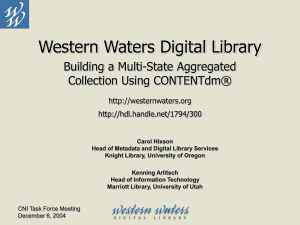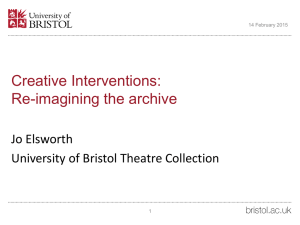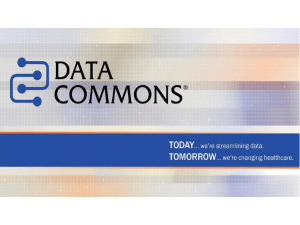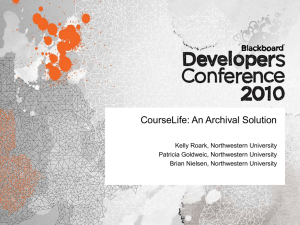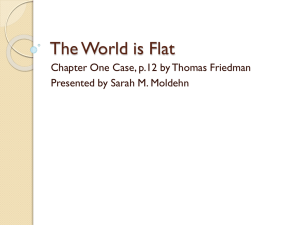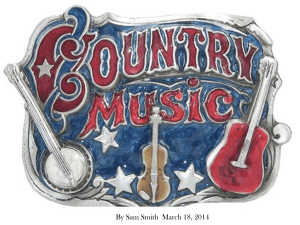Occupy
advertisement
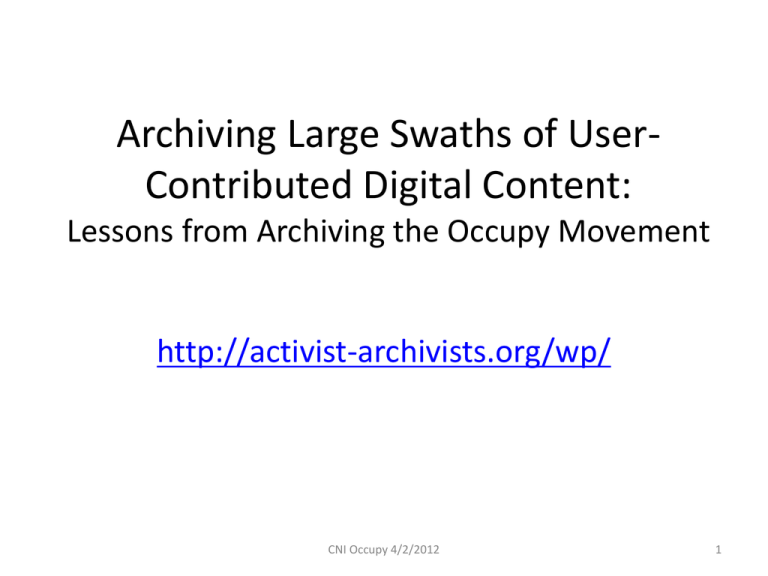
Archiving Large Swaths of UserContributed Digital Content: Lessons from Archiving the Occupy Movement http://activist-archivists.org/wp/ CNI Occupy 4/2/2012 1 What’s interesting/important about Occupy? CNI Occupy 4/2/2012 2 March 24, 2012 Flickr stats • • • • • • • “#Occupy” 632,089 “Occupy Wall Street” 164,304 “Occupy Protest” 179,454 “Occupy Movement” 40,572 “#OWS” 113,904 “Occupy Oakland” 27,202 “Zucotti Park” 9,164 CNI Occupy 4/2/2012 3 What’s interesting/important about Occupy? CNI Occupy 4/2/2012 4 How Occupy material resembles what we’ll be facing in the future • Vast quantity of user-contributed material • No easy way to control for quality, file format, metadata – no enforcing guidelines as with organizational records – no semi-consistency as in a single individual’s personal records • Much of the material can most easily be found on Social Networks • Need to find smart ways to harvest metadata and analyze files, as well as to influence behavior of potential contributors CNI Occupy 4/2/2012 5 How this material may (or may not) be different • Huge suspicion of conventional organizations (incl universities and libraries) • DIY mentality—want to control own story • Reluctance to sanction turning over material to an institution • Consensus Process becomes more difficult when each meeting attracts a different set of people CNI Occupy 4/2/2012 6 OWS Archives Working Group CNI Occupy 4/2/2012 7 What I know from my prior work • InterPARES—If we hope to preserve electronic records, archivists need to be involved early in the life-cycle of that record, long before the record enters the archive • Preserving Digital Public Television—Pushing metadata gathering upstream into the production cycle CNI Occupy 4/2/2012 8 Archiving Occupy Media• Howard Besser, Activist Archivists • David Millman, NYU Libraries • Sharon Leon, George Mason U, Cntr for History and New Media • Kristine Hanna/David Millman, Internet Archive Archive-It CNI Occupy 4/2/2012 9 Activist Archivist Website CNI Occupy 4/2/2012 10 CNI Occupy 4/2/2012 11 CNI Occupy 4/2/2012 12 CNI Occupy 4/2/2012 13 Activist Archivists Projects• “Why Archive” postcard • 7 Tips to Ensure Your Video Is Usable in the Long Term • Study of metadata loss through uploading to services • Best Practices for Creators/Collectors • “Toolkit” for Occupy archiving • Coordinating discussions among various groups archiving different parts of Occupy • Exploring methods for obscuring identities CNI Occupy 4/2/2012 14 “Why Archive” postcard • ACCOUNTABILITY. Archives collect evidence that can hold those in power accountable. • SELF-DETERMINATION. We define our own movement. We need to create and maintain our own historical record. • SHARE. Archives are a point of entry to our movement’s rich record. We can use them to ensure transparency, generate discussion, and enable direct action. • EDUCATE. Today’s videos, flyers, web-pages, and signs are material for tomorrow’s skill-shares, classes, and mobilizations. • CONTINUITY. Just as past movements inspire us, new activists will learn from the experiences we document. • R E C O R D & C O L L E C T what’s happening around you. • P R E S E R V E the record. CNI Occupy 4/2/2012 15 7 Tips to Ensure Your Video Is Usable in the Long Term • • • • • • • Collect details while filming Keep your original raw footage, unaltered Make your video discoverable Contextualize it Make it verifiable Allow others to collect and archive Or archive it yourself CNI Occupy 4/2/2012 16 Study of metadata loss through uploading to services CNI Occupy 4/2/2012 17 Best Practices for Content Collectors • Security – Sensitive material – Scraping for content • Content Search – Internet Archive, Archive-It, YouTube, Vimeo, Bit-Torrent • Receiving Content • Metadata Extraction • Copyright CNI Occupy 4/2/2012 18 Best Practices for Content Creators • Security – Hidden camera laws, parties’ consent laws • Capturing Content – Highest quality, set date and time-stamps, note location • Offloading Content – Raw files directly onto computer, keep material organized • Uploading Content – Importance of tagging, review of diff services • Depositing with an Archive • Copyright CNI Occupy 4/2/2012 19 Occupy Archiving Kit • • • • • • • • • • • • Why Archive? What is an “archive”? How do I create an archive? Creating archiving-friendly content How can I collect materials for the archive? What should I save? How should I organize my materials? How do I get it into the archive? Description/Metadata Media Management Storage & Preservation Access Exhibition and Presentation/Outreach Rights and Re-Use CNI Occupy 4/2/2012 20 Skill-shares for Occupiers CNI Occupy 4/2/2012 21 OWS Archive Share Day used variety of tools CNI Occupy 4/2/2012 22 Bulkr • Batch download from FLICKR • Set selection filters (#OWS, Creative Commons) • Set what elements you want to grab (essence, EXIF metadata, tagged-text metadata CNI Occupy 4/2/2012 23 Downloaded FLICKR image CNI Occupy 4/2/2012 24 Downloaded EXIF metadata CNI Occupy 4/2/2012 25 Other Archive Share-Day and Hackathon activities • Re-mixing of older footage • Creating a visual timeline • Mining material for data (eg. number of colocations of an officer’s name with “pepper spray”) CNI Occupy 4/2/2012 26 Creative Commons Guidance • Creative Commons lets you mix-and-match four different conditions: – Attribution: You let others copy, re-use and distribute your video, but they must credit you. – Share-Alike: You let others copy, re-use and distribute your video, only if they do the same with the work they create. – Non-Commercial: You let others copy, re-use and distribute your video for non-commercial purposes only. – No Derivative Works: You let others copy and distribute your video, but not to create new works using it. • You can use these conditions in different combinations to share your work in a controlled way. Creative Commons licenses are legal tools that depend on pre-existing copyright laws. Having a Creative Commons license on your work may give you legal recourse, but it may not actually prevent people from downloading and re-using your video illegally. CNI Occupy 4/2/2012 27 Marking Creative Commons licenses • There are a few ways to mark your video with a Creative Commons license. One way is to include a Creative Commons “bumper” or text card in your video. Creative Commons has created some with graphics that you can download from their website. This method is useful if your video is going to be shared offline (e.g. on DVD, live screenings), as the license information is attached to the video itself. • Another way to mark your video with a Creative Commons license is to publish your video on platforms that are Creative Commons-enabled, such as YouTube, Vimeo, or Internet Archive. These platforms allow you to easily select a license during the upload process. This method is useful because the license is machine-readable. A search engine, for example, can detect the license. CNI Occupy 4/2/2012 28 Promoting ObscuraCam • “ObscuraCam is a visual privacy app for photo and video, that gives you the power to better protect the identity of those captures in your photos, before you post them online” • Developed by Guardian Project in conjunction w/Human Rights group WITNESS- CNI Occupy 4/2/2012 29 ObscuraCam CNI Occupy 4/2/2012 30 Activist Archivist Collaborations• With Occupy Wall Street groups – Helping store and manage Media Working Group’s media streams • With Tamiment Collection – Methods for collaborative selection of YouTube videos – Methods for extracting metadata from recordings CNI Occupy 4/2/2012 31 Occupy’s Media Working Group— Streaming Services (1/3) • livestream, ustream—almost impossible to hack into downloads • One of Occupy Oakland’s streamers uses the streaming service as his fileserver. – does no recording onto local media (to avoid confiscation of equipment) – when he wants to edit, he downloads from streaming service, edits, then uploads it back – trusts the streaming service, and thinks that it will be around forever CNI Occupy 4/2/2012 32 Occupy’s Media Working Group— Streaming Services (2/3) • OWS keeps masters for their streams and other media locally, and as numbers grow, they’re having trouble with managing the files and storage and want a DAM, but… – Activist Archivists (AA) brokered a deal to put copies of their content on a reliable archival service – AA helped them select open source tool to use for cataloging (Omeka), and AA volunteer is currently cataloging their mini DV collection of footage from all General Assemblies and Spokes Councils from September 17th to date-CNI Occupy 4/2/2012 33 Cataloging GA/Spokescouncil mini-DVs CNI Occupy 4/2/2012 34 Metadata for OWS Core google doc CNI Occupy 4/2/2012 35 Omeka for Cataloging/Managing CNI Occupy 4/2/2012 36 Occupy’s Media Working Group— Streaming Services (3/3) • Currently working on plan to turn over the Global Revolution streaming collection to NYU’s Tamiment – OWS will NOT sign a donor agreement, as they see that as conferring exclusivity to a bureaucratic organization – Instead, OWS will execute a Creative Commons license letting anyone else use the material, and AA volunteers will make sure that the corpus is transferred to NYUCNI Occupy 4/2/2012 37 YouTube • Tamiment has been selectively browsing through YouTube Occupy videos, trying to choose which ones to keep, then cataloging them with – Title, Creator, Creation Date, Upload Date, Description, URL, Youtube Username, License, Format, Codec, Source Media, On Internet Archive, CC License type CNI Occupy 4/2/2012 38 Tamiment YouTube Cataloging CNI Occupy 4/2/2012 39 But this won’t scale! CNI Occupy 4/2/2012 40 March 24, 2012 YouTube stats • • • • • • • “#Occupy” 169,000 “Occupy Wall Street” 98,400 “Occupy Protest” 70,500 “Occupy Movement” 54,800 “#OWS” 50,300 “Occupy Oakland” 13,400 “Zucotti Park” 6,690 CNI Occupy 4/2/2012 41 Alternative approach to YouTube Selection process • Develop categories of important YouTube videos – Celebrity visits, Internal workings (library, kitchen, media), Confrontations with police, Labor, Housing, etc. • Have Occupiers fill in an online form listing the 5 most important videos in each category CNI Occupy 4/2/2012 42 Advantages of YouTube Collaborative Filtering Selection Process • Scalable and manageable • Consistent with Occupy ideas of inclusiveness and of managing own story • Tamiment can still choose to be selective in collecting only a portion of what is voted in, but the total set for review is a manageable scale CNI Occupy 4/2/2012 43 Social Networks starting to police their “Terms of Use” CNI Occupy 4/2/2012 44 YouTube User Agreement • 5B “You shall not download any Content unless you see a ‘download’ or similar link displayed by YouTube on the Service for that Content.” CNI Occupy 4/2/2012 45 But even 1916 Public Domain material on Creative Commons YouTube Channel don’t have “download” button CNI Occupy 4/2/2012 46 YouTube sees Creative Commons as only for Re-Mix, not archiving CNI Occupy 4/2/2012 47 But using YouTube’s video editor to view and “Re-Mix” exact copies is probably legal CNI Occupy 4/2/2012 48 Archiving Occupy Media• Howard Besser, Activist Archivists • David Millman, NYU Libraries • Sharon Leon, George Mason U, Cntr for History and New Media • Kristine Hanna/David Millman, Internet Archive Archive-It CNI Occupy 4/2/2012 49

